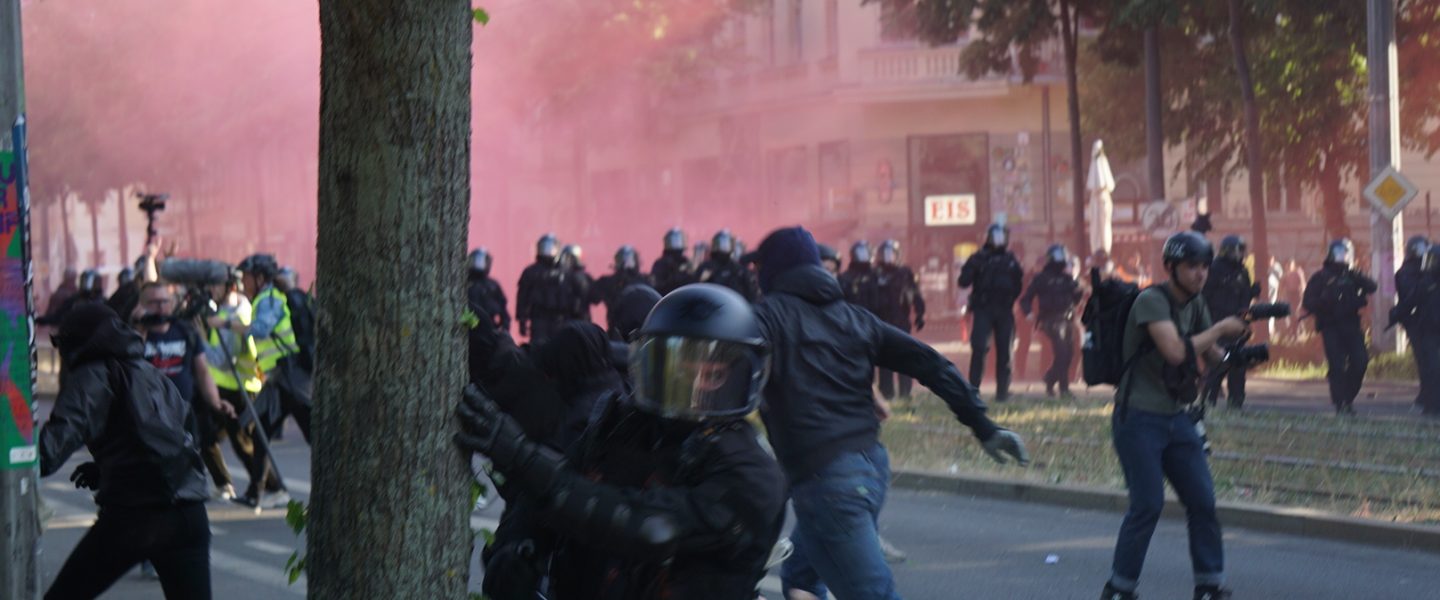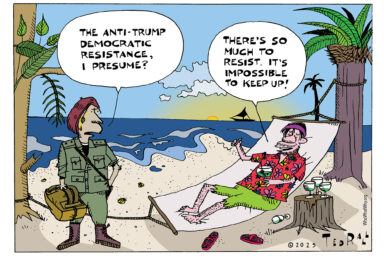A German protest says a lot about the rise of the far Right, how we understand the far Left, and whether laws restricting speech really do much.
|
Listen To This Story
|
As far-right political groups gain power in Europe, governments are tested in their tolerance for protest and outright violence. In Germany, a recent court decision revealed how conflicting policies (or lax enforcement) reach absurd proportions — and how shallow media coverage misrepresents political extremism.
On June 3, around 1,000 far-left protestors gathered in Leipzig to protest prison sentences for a 28-year-old student and three accomplices who were convicted on May 3 of orchestrating a string of attacks against neo-Nazis in Germany.

The woman, referred to only as “Lina E.” (in accordance with Germany’s strict privacy laws), was sentenced to five years and three months in custody for six attacks against neo-Nazis in the eastern Germany states Thuringia and Saxony from August 2018 to the summer of 2020. The attacks included raiding a well-known neo-Nazi bar in the town of Eisenach in 2019, where Lina and accomplices allegedly assaulted a notorious far-right extremist, Leon R., with hammers and batons. In all, Lina E. and her associates injured 13 people. Her three male accomplices were each sentenced to three years.

The outcry against the rulings led far-left extremists to launch demonstrations throughout Germany with the tagline “#FreeLina.” In Leipzig, police tried to ban the large influx of leftists who had planned demonstrations throughout the city and made arrests when the protests became violent.
The outcry against the rulings led far-left extremists to launch demonstrations throughout Germany with the tagline “#FreeLina.” In Leipzig, police tried to ban the large influx of leftists who had planned demonstrations throughout the city. At Leipzig’s Alexis Schumann Square, dozens of police gathered in riot gear to face the leftists. During the first two hours of the event, protestors remained calm, chanting “Freedom for Lina.” But then something set the leftists off, causing the scene to erupt into chaos. Some protestors threw red smoke bombs, glass bottles, and cement bricks into the crowd of police.
In response, police pushed groups of protestors back and made arrests, injuring some in the process. “Please continue to behave peacefully,” an officer said over a megaphone.

Media coverage of the protest violence focused on the “news,” as in the case of an Agence France Presse wire story headlined “Dozens Injured In ‘Senseless’ Far-left Protest In Germany.” The article quoted Germany’s Interior Minister Nancy Faeser calling out “senseless violence.” In a statement, Faeser said far-left violence represented “significant danger” and that “this radicalization and spiral of violence must not be allowed to continue … there must be no room for vigilante justice in a democratic constitutional state.”
Shallow media coverage of far-left and far-right activities can create a false equivalency. A professor who studies extremism told German outlet DW that Lina E.’s actions qualified as “clandestine structures,” which the article interprets as the professor saying “could well be described as terrorist.”
Missing from most reports is some necessary context about the rise of the far Right. The surface telling of the AFP story and others renders the protest anomalous, presenting it as fundamentally isolated to the trial, rather than as one page of a larger political narrative.

It is not an endorsement of the “Free Lina” movement for a story to point out, for instance, that the protests occurred at a time when right-wing attacks in Germany are on the rise — up 10 percent by the end of 2021. Or that in May 2022, before Faeser called out a left-wing “spiral of violence,” she said that “right-wing violence poses the biggest extremist threat to our country’s democracy and to our people.”
This dichotomy should sound familiar to US media consumers, who in the last few years have heard American news consider whether Antifa is an organized terrorist threat or a small-scale response to the rise of right-wing movements in the US.
What makes the Leipzig protests interesting is that while, like Antifa, they too are a response to far-right ascendance, Germany (unlike the US) has written into law its attempts to curb neo-Nazi ideology and Holocaust denial.

The German Penal Code section 130 prohibits any glorification of the Nazi regime. Under section 86, any use of symbols, slogans, or greetings related to the Nazi regime is also prohibited. And yet, in 2020, there were at least 33,300 far-right extremists in Germany — a 4 percent increase from the previous year, according to German Interior Minister Horst Seehofer. Last December, the neo-Nazi group Citizens of the Reich, which denies the existence of Germany’s post World War II republic, made international news when it tried to overthrow the German government. Despite Germany’s laws, it was overlooked for 25 years as it grew to 23,000 members.

Mainstream US coverage of the trial and the protest almost entirely omit this context about the state of the far Right in the European Union, or the fact of its ascendance in Germany happening in spite of laws restricting hate speech. Those laws should be particularly interesting for Americans to consider as we reckon both with our own extremism and the consequences of our hallowed laws of free expression.
A few weeks after the protest, at the end of June, a candidate from the far-right Alternative for Germany party (known as AfD in Germany) won a district administrator seat in a part of Thuringia, one of the states where Lina E. allegedly staged her attacks.
Lina E. and her accomplices, meanwhile, are out of prison for now, pending their appeals. The story of her case (and any fallout from the protest) have vanished from the news. But the larger story continues.




